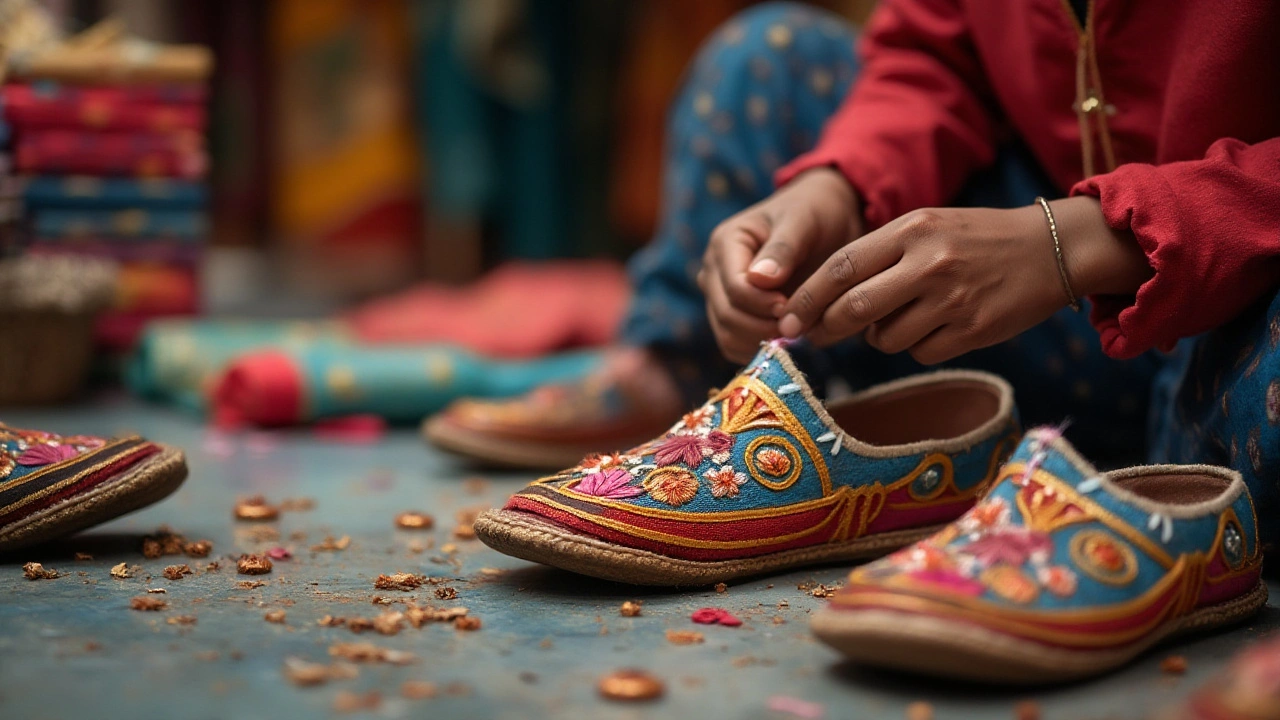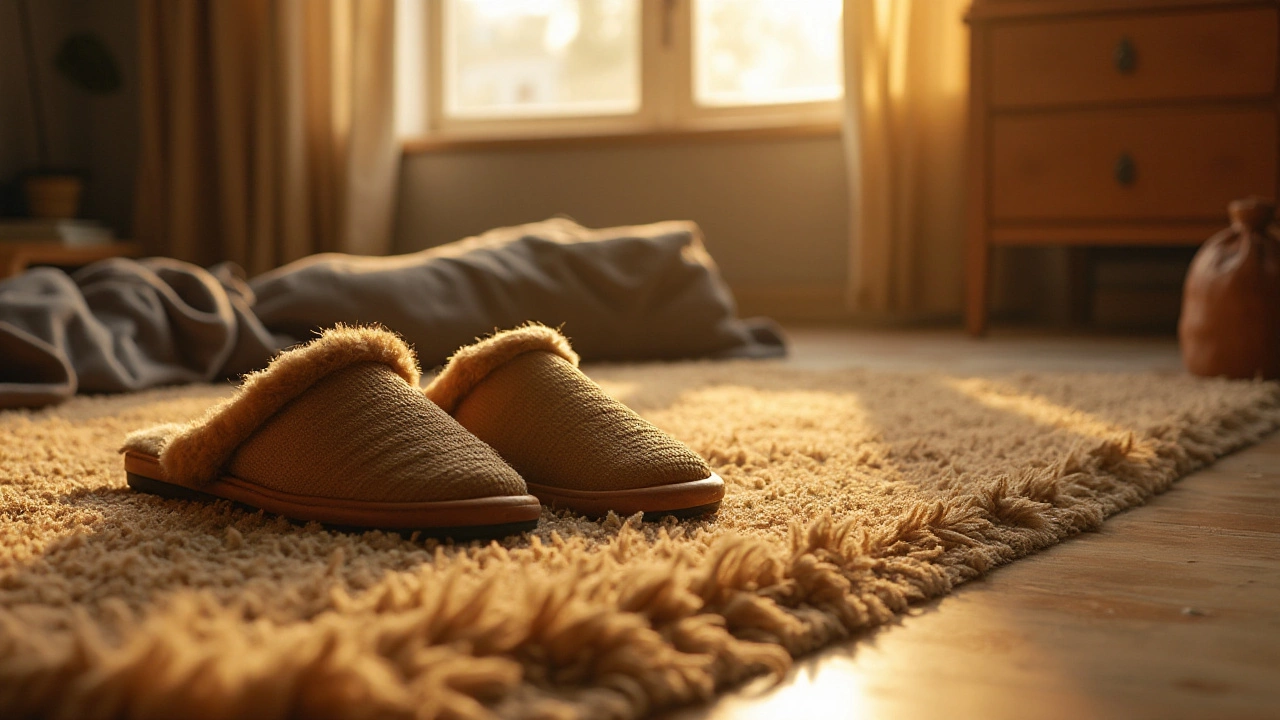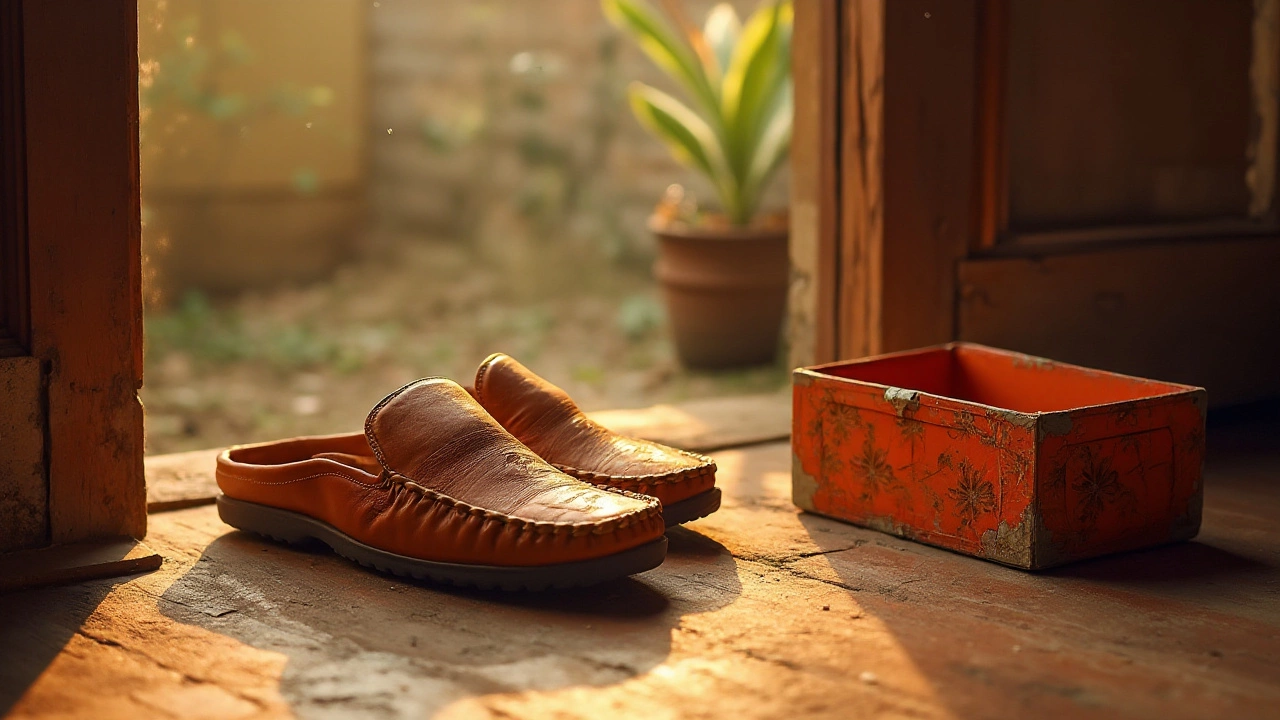There's a simple joy that comes from sliding your feet into a pair of well-worn slippers, where the fabric hugs your toes and the soles offer a cushioned perch. Yet, like anything we rely on, slippers don't last forever. Knowing when to part ways can sometimes be a tricky decision.
Beyond the visible wear and tear, there are hidden signals our slippers send us. These trusty companions bear the brunt of our daily steps, but there's a fine line between cozy and overly worn. Let's unravel the art of slipper replacement, and find out just when it's time to introduce your feet to a new pair.
- Signs Your Slippers Need Replacing
- Impacts of Wearing Worn-Out Slippers
- Prolonging the Life of Your Slippers
- Choosing the Right Time for a New Pair
- Tips for Selecting New Slippers
- Environmental Considerations and Disposal
Signs Your Slippers Need Replacing
Slippers hold a unique place in our wardrobe as purveyors of comfort and warmth. They are the first thing we seek in the morning and often the last thing we slip off before bed. Over time, however, these cozy companions can begin to show signs of wear. The first telltale sign is usually the decline in support. Most slippers begin their life offering adequate cushioning and support, but as the padding compresses and wears down over time, they turn flat, diminishing their role as a protective layer for your feet. Without adequate support, you may experience discomfort or even pain during prolonged wear, which signals that it is likely time for a replacement.
A visual inspection might reveal obvious signs of wear, such as holes in the fabric or thinning soles. Fabric tears can expose your feet to cold floors, defeating the very purpose of wearing them. Look for signs of sagging structure or misshapen form, as these often indicate that the internal materials have degraded. An unpleasant odor might also develop if the slippers are well-loved, since moisture and bacteria accumulation happens when slippers are not regularly cleaned. If you notice that scent lingers even after washing, it might be time to introduce a new pair into your home.
Aside from these, your slippers' fit is an important indicator. Ill-fitting slippers can lead to problems like blisters or irritation. If you find that your slippers are slipping off too easily or feel cramped, it might be due to fabric stretching or shrinkage from washes. This lack of fit could be a clear sign that it's time to rejuvenate your collection. According to a study by the American Podiatric Medical Association, around 20% of Americans experience footwear discomfort, often due to worn out slippers or shoes.
In fact, Dr. William A. Rossi, a noted podiatrist, once said, "The right footwear isn’t just about protection, but about enhancing overall foot health." This highlights how vital the correct, well-maintained slippers are for maintaining comfort and health at home.Long-lasting slippers might serve you months or even years, depending on their quality and use frequency. High-quality leather or synthetic options may offer better durability than fabric slippers, which tend to degrade quicker when they're subject to regular wear and washing. For optimal slipper longevity, consider alternating pairs to allow each a chance to dry completely between wears, reducing moisture buildup and material breakdown.
The detail-oriented slipper enthusiast will also pay attention to the sole. A favorite slipper may lose its grip over time, increasing the risk of slips and falls, especially on smooth surfaces. Inspect the soles for wear patterns; if you see bald spots appearing where there used to be tread, it's a sign that the slipper's once steadfast grip has diminished, inviting a potential hazard. Ensuring that your slippers have proper traction is not just about comfort, but safety as well.
Impacts of Wearing Worn-Out Slippers
When it comes to maintaining home comfort, we often overlook the importance of our reliable slippers. However, holding on to them past their prime can lead to bigger issues than one might anticipate. As slippers age, their structure and materials begin to break down. This degradation results in loss of support, which is essential for maintaining the integrity and comfort of your feet. Poor support can lead to issues like plantar fasciitis, arch pain, and even knee problems, emphasizing the importance of replacing worn slippers.
Beyond physical discomfort, wearing old slippers can impact the hygiene of your home. Used slippers tend to accumulate sweat over time, which can lead to unpleasant odors or even mold formation. Mold isn't just unappealing; it can also become a breeding ground for allergens and bacteria, potentially affecting your overall health. A regular washing routine helps, but there's a point where slippers have taken a hit too many. Experts suggest that incorporating a routine of replacing footwear every six months to a year can mitigate such risks.
Another factor often ignored is the psychological impact of not taking care of our comfort items, like slippers. According to studies, having a clutter-free and updated environment contributes positively to mental well-being. Worn-out slippers, with their tired looks and musty scent, can subtly add to daily stressors. The deceptively intimate interaction we have with our slippers means that fresh, comfortable pairs can improve our mood and energy levels throughout the day. It’s an unsung hero of our routine that deserves attention just as much as any other daily essentials.
Finally, there is the consideration of slipping hazards. The sole of well-loved slippers can wear smooth, losing the grip needed on slick surfaces like kitchen tiles or wooden floors. Worn slippers increase the risk of accidents, especially among the elderly or very young, who are more susceptible to falls. In high-traffic homes, replacing these is not just a personal comfort need but a safety precaution. To minimize these risks, check your slippers' grips regularly.
"Your feet are the foundation of your body. Supporting them well can support your entire being," says Dr. Dana Canuso, an expert in podiatric medical care, stressing the importance of maintaining footwear like slippers for optimal health.
The decision to replace slippers is often delayed by sentiment or sheer forgetfulness, but understanding the underlying impacts of keeping old ones in service makes the choice clearer. They support our every step at home, and keeping them in their best shape or introducing a fresh pair when needed isn’t just about luxury; it’s about sustaining our wellbeing and security in our personal sanctuary.

Prolonging the Life of Your Slippers
When it comes to slippers, they tend to be those cozy go-tos that often get overlooked until they're falling apart at the seams. But with a tad of TLC, you can keep your trusty footwear in excellent shape much longer than you might expect. First off, alternating between two pairs can greatly increase their lifespan. Just like any shoe, giving them a day or two to rest and dry out can do wonders. Moisture weakens fabrics and foam, making them less supportive and comfy over time.
Cleaning is another vital step. For most slippers, a gentle hand wash with mild soap does the trick. If they're machine washable, ensure you use cold water to prevent shrinking or degrading materials. Air drying is best; dryers can wreak havoc on the delicate fibers. Placing them in a sunny spot is ideal, as direct sunlight can eliminate unwanted bacteria. What's more, always remember to remove any debris that might have lodged into the soles as it can wear down your slippers quicker.
Sometimes, professional cleaning might be in order. According to James Turner, a footwear restoration specialist, "Regular maintenance can extend a slipper's life significantly. However, periodic deep cleaning—especially for expensive or delicate pairs—can prevent deterioration and maintain hygiene." This doesn’t just improve longevity, but also ensures your home comfort is not compromised by unclean footwear.
The materials used for making slippers play a role too. Natural fibers like wool and cotton breathe better than synthetics, which helps reduce odor and moisture accumulation. If you’re dealing with odor issues, sprinkle a bit of baking soda inside and let them sit overnight to neutralize smells. Fabric protectors also provide a shield against spills and stains, while sole protectors safeguard the bottoms against excessive wear. Remember, investing a little time in care goes a long way in extending that blissful feeling of slipping into your favorite pair.
With just a few small adjustments in how you care for them, you can preserve the function and aesthetic of your slippers. Don't forget that a proper fit is a vital aspect, as slippers that are either too tight or loose can degrade faster. A snug pair allows less friction and slippage, especially when you’re lounging around or doing light housework. Ultimately, the little efforts put into maintenance not only keeps your feet cozy but can also save you money in the long run.
Choosing the Right Time for a New Pair
Slippers occupy a unique niche in our daily routines. Often, they straddle the line between being a necessity and a luxury. Identifying the precise moment to replace them involves more than just acknowledging visible wear and tear. Your feet, sensitive to changes in support and texture, can often tell you when it's time for a new pair. Ignoring these signs can lead to unnecessary discomfort or even foot health issues.
Wear and tear doesn't always manifest as holes in your slippers. Sometimes, the changes are subtler, like a diminished arch support or the flattening of cushioning. Over time, slippers lose their ability to provide proper support, potentially affecting your posture and gait. In fact, neglecting these subtle hints might lead to fatigue in your feet and legs. Listening to your body is key—if your feet feel more tired than usual after wearing your slippers, it might be time for an upgrade.
Another factor to consider is the hygiene aspect. As you wear your slippers daily, they can accumulate sweat and bacteria, which even regular washing might not fully remove. This can eventually lead to odors or skin irritations. As a rule of thumb, if you've been wearing the same pair for more than a year, it might be time to switch, especially if they’re not washable.
Seasonal changes can also guide you in making the decision. During colder months, you might want slippers with thicker insulation and a more robust build to fend off the chill. Warmer weather may call for lighter, breathable materials. Not only does this seasonal swap improve comfort, but it can also help extend the life of multiple slipper pairs by rotating them.
"Comfort takes precedence, but consider longevity and hygiene," advises Dr. Maria Concetta Borrelli, a podiatrist with a focus on footwear. "Replacing slippers regularly is a small step towards better foot health."
It’s also worth noting that footwear care extends to slippers. You can spot-clean them regularly or check manufacturer recommendations on keeping them fresh. Some brands even suggest specific timelines for replacing their products based on material composition and usage level.
When it's time to shop for a new pair, make sure you consider factors such as your home's flooring type, your temperature preferences, and any specific foot issues you might have. The right slipper not only fits your foot but matches your lifestyle. Remember, the goal is to keep your feet happy and comfortable, day in and day out.

Tips for Selecting New Slippers
Choosing the right pair of slippers can be more than just a style decision; it directly impacts home comfort and foot health. The market is teeming with styles, materials, and brands, which can make picking the perfect pair overwhelming. First, consider the material. Soft fleece and fur are delightful when you slip them on, especially in colder months, but be wary, as these can feel overly warm during summer. For year-round comfort, cotton or wool blends can offer breathable warmth without overheating. Leather and suede add a touch of luxury and durability but may require more maintenance, like regular cleaning and conditioning, to maintain their appearance.
Focus on the structure and support of the slippers. While many view slippers as a temporary retreat for the feet, the wrong pair can lead to discomfort or even pain. Look for slippers with firm, cushioned soles that offer arch support. Platforms that combine memory foam core with a durable outsole can provide the comfort and protection needed for both carpeted terrains and bare, wooden floors. Dr. Emily Splichal, a renowned podiatrist, once remarked,
"Your feet deserve as much attention indoors as those expensive sneakers you reserve for the gym. Quality slippers support the foot and enhance your overall posture."Keep this in mind when trying out new pairs. Ensure they aren't too loose or too tight. A snug fit prevents slipping, which is particularly important when ascending or descending stairs.
Next, match your lifestyle to the slipper style. If you're someone who prefers to chill on the couch with a good book on the weekend, plush, enveloping slippers might be your best bet, ensuring each curl of your toes is met with soft delight. On the other hand, house-bound fitness enthusiasts might appreciate slip-ons with grips, like those resembling a sports sandal. A slipper with a back or a sturdy heel strap is perfect if you tend to wander in and out of the house frequently. As for aesthetics, go for colors and styles that complement your wardrobe. Bolder, brighter colors can spark a little joy whenever you glance down, but classic neutrals are typically versatile, matching anything you don.
Consider the impact on the environment and the footprint slippers leave behind. Sustainable materials, such as recycled rubber or organic cotton, present an eco-friendlier choice. Opting for brands that prioritize ethical production processes can support both your feet and the planet. A 2019 study revealed that the footwear industry generates a significant carbon footprint; choosing wisely can impact this statistic. Furthermore, aiming for brands committed to minimal waste or packaging can further reduce environmental effects. Making informed, conscious choices not only meets personal needs but aligns with larger global sustainability goals too.
Lastly, before purchasing any pair, think about durability and price. Cheap slippers might be easy on the wallet initially, but they could wear out embarrassingly quickly. Investing in a quality pair might seem like a frugal luxury, but the trade-off usually means longer-lasting slippers that hold up under daily use. Read reviews, seek recommendations, and even check out what your favorite influencers wear at home. As we all put our feet up and seek that comfort haven beneath our toes, finding the right slippers becomes an essential part of our daily winding down.
Environmental Considerations and Disposal
Getting rid of your old slippers is more than just tossing them in the trash. In our throwaway culture, it's easy to overlook the impact of disposal on the environment. Many slippers are made from synthetic materials that aren’t biodegradable, which means they sit in landfills for decades. It’s important to consider environmentally friendly methods of disposal to reduce our footprint. Start by checking if the manufacturer offers a recycling program. Some brands have initiatives to collect old slippers, recycle the materials, and explain the process. This can offset a good portion of the environmental damage caused by simply throwing them away.
When you're in the market for new slippers, think about choosing ones made from natural materials like cotton, wool, or responsibly sourced leather. These can break down more efficiently and have less impact if they do end up in a landfill. If the current options don't strike your fancy, consider repurposing your old slippers creatively. They can become plant holders, door stoppers, or even toys for pets. The idea is to extend the life of the product in any small way possible before it hits the garbage.
Recycling Slippers
Recycling is an option that allows the elements of footwear to serve again. The recycled material can be used for various purposes like playground surfaces or insulation. It’s often a community effort, and some local environmental groups may be involved with coordinating these efforts. Look out for local events focused on recycling shoes and footwear. Keep in mind, however, that not all slippers can be recycled due to mixed materials. You may need to segregate parts like foam or rubber soles that require special recycling processes.
"We do not inherit the earth from our ancestors, we borrow it from our children." — Native American Proverb
Donating and Repurposing
If your slippers are still in decent shape, consider donation as a viable option. Various charity organizations accept gently used footwear and delivering them can improve someone’s life significantly without you realizing. Look into organizations that work internationally; they often have high demand for footwear. Yet, before donating, ensure they're cleaned and in good condition. There's a responsibility in donations not just to give, but to ensure what you give is useful. Repurposing within your home is another creative option. As mentioned earlier, your home comfort items can find secondary use as cleaning tools for dusting corners or polishing.
In the end, the goal is not just to dispose but to do so in a way that minimizes our environmental impact. Every pair of slippers represents both the effort of production and the necessity of disposal. Thoughtful consideration and a bit of creativity can go a long way in ensuring that your comfort doesn’t come at too high a cost to the planet.

